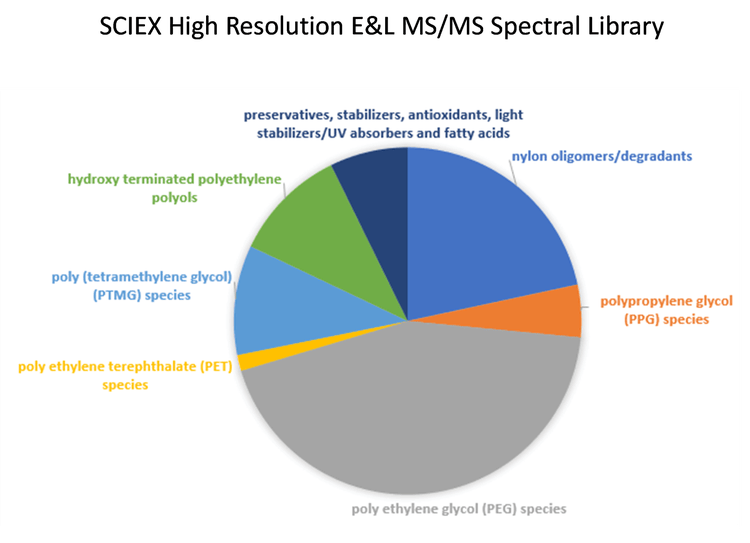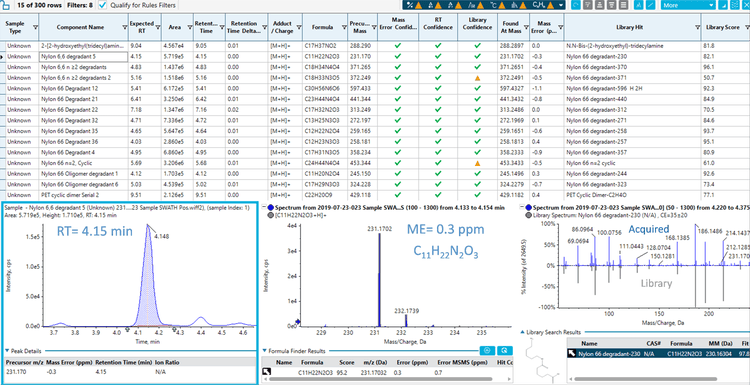Abstract
Confident extractables and leachables (E&L) identifications from plastics are essential for exposure and toxicological studies. The flexibility of SCIEX instrumentation and software solutions provide scientists a fast way to analyze large batches of samples with accurate and efficient MS/MS library searching for compound identification, data mining, and compound database management for E&L analysis. The SCIEX Open Access Extractables and Leachables MS/MS spectral library is a comprehensive MS/MS spectral library containing 675 E&L relevant compound entries. This library in combination with powerful search algorithms enables specific, sensitive, robust, accurate and efficient compound identification through instrument specific library MS/MS spectral matching.
Introduction
Confident identification of extractables and leachables (E&L) from plastics is essential for exposure and toxicological studies. The flexibility of SCIEX instrumentation and software solutions provides scientists with a fast way to analyze large batches of samples, with accurate and efficient MS/MS library searching for compound identification, data mining, and compound database management for E&L analysis.
The SCIEX E&L high-resolution MS/MS spectral library is a comprehensive library containing 675 E&L relevant compound entries. This suite of compounds is highly useful for scientists performing chemical analysis of non-volatile species on multiple material types, including plastics and polymers. This library, in combination with powerful search algorithms in SCIEX OS software, enables specific, sensitive, robust, accurate and efficient compound identification through instrument specific library MS/MS spectral matching. Combine it with a curated subset of the licensed National Institute of Technology (NIST) MS/MS spectral library to obtain a comprehensive library bundle containing only relevant compounds (2,360) for enhanced coverage, to reduce the number of times unknown peaks from E&L studies are not identified.

Key features of the SCIEX E&L spectral library
- Includes a SCIEX proprietary 675 E&L compound specific library
- Library includes polymer degradants covering nylon oligomers/degradants, polypropylene glycol (PPG) species, polyethylene glycol (PEG) species, piperidinones, polyethylene terephthalate (PET) species, polytetramethylene glycol (PTMG) species and hydroxy-terminated polyethylene polyols, as well as other polymer components, preservatives, stabilizers, antioxidants, light stabilizers/UV absorbers and fatty acids (Figure 1)
- The SCIEX instrument specific E&L library is freely available to download from the SCIEX.com website, in the standard SCIEX LibraryView (.lbp) format
- Contains high resolution MS/MS spectral data from both positive and negative ionization for library matching of MS/MS data acquired on SCIEX QTRAP and QTOF systems
SCIEX OS software for compound identification
SCIEX OS software allows easy adoption and implementation of E&L screening and quantification workflows with intuitive data representation and interpretation to quickly report out accurate, confident E&L results. Combined with the SCIEX and NIST E&L libraries, researchers can search and identify compounds across a breadth of E&L compound classes to enhance the accuracy and efficacy of both targeted and non-targeted screening.
- Use the integrated MS and MS/MS information from the library to build methods without the need to infuse standards and optimize conditions for a given compound
- Easily create processing methods for IDA or SWATH acquisition workflows for use on SCIEX QTOF systems
- Quickly setup XIC tables for quantification and identification with SCIEX OS software
- Build customized libraries by simply selecting only the compounds of interest using the LibraryView software features.
More confident compound ID with high resolution MS/MS
High resolution mass spectrometry (HRMS) using the SCIEX QTOF systems provides investigators a powerful tool for the detection and identification of extractables and leachables. High MS and MS/MS acquisition rates ensure the acquisition of accurate mass spectral data on large numbers of analytes, even at low analyte concentrations. The comprehensive analyte-specific MS/MS spectra increases the specificity and confidence in the results when performing compound identification.
Automated processing matches the MS data to the analyte mass, and the MS/MS data are matched to the analyte fragmentation pattern in the library. As shown in the example in Figure 2, multiple points of high-quality data are used to detect and identify extractables and leachables from an acetone tubing extract sample. Highlighted is an example of the identification of a nylon degradant with an excellent fit score of 97.8% for the spectral matching of the acquired MS/MS spectrum to the SCIEX E&L library spectrum.

Conclusions
The SCIEX E&L solution combining compound specific libraries with powerful high resolution QTOF systems provides a robust solution for researchers performing chemical analysis for non-volatile species from various plastics and polymers across a wide range of matrices. The library consists of MS/MS spectra that have been acquired on a SCIEX QTOF system enabling MS/MS spectral library searching with spectra that will be similar across all SCIEX systems. Powerful and stringent search algorithms in SCIEX OS software reduce the false positives, keeping the number of library hits to a relevant and minimal number. The specific, sensitive and robust library match, in combination with retention time and mass error, provide confidence in accurate identifications.
References
- Comprehensive workflow for the analysis of extractables and leachables from laboratory tubing. SCIEX technical note, RUO-MKT-02-10601-C.
- Single acquisition, multi-analysis strategy for identifying and quantifying extractable and leachable compounds. SCIEX technical note, RUO-MKT-02-11284-A.
